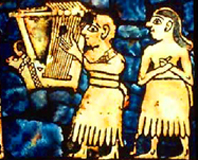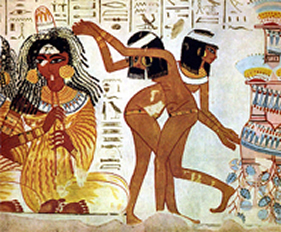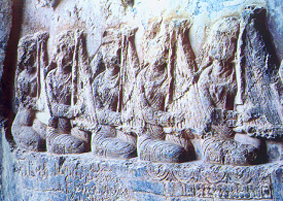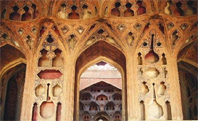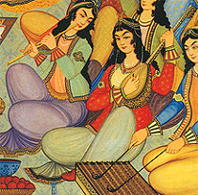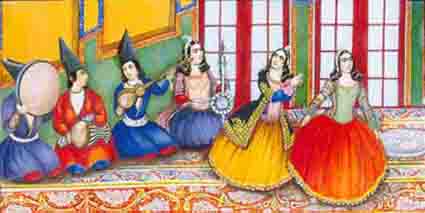Music in Iran dates back to antiquity. Evidence of musical instruments, musical performances, singing and dancing, exist as far back as the Sumerian culture. The Elamites, centred in southwestern Iran must have carried over these musical traditions. Not much is known about that period. However, archeological evidence has revealed a number of Sumrian musical instruments that were used in Iran during the 2nd and 1st millennium BC.
Not much is known about the early Medes or Achaemenids periods either, except that music played an important role in state ceremonies, especially in religious affairs, during the Achaemenid rule. It is known that ancient Iranians had hymns which were collectively performed and that during the Achaemenids there were specially trained groups which performed these hymns. During the Parthian era, we know of the existence of groups of troubadours who were highly sought after as entertainers. The first evidence of poetry reading or singing performances accompanied by music comes from this period.
Music also played a very important role in the courts of Sassanid kings; and about its later stages we know a lot more. We know, for example, the names of various court musicians like Ramtin, Bamshad, Nakisa, Azad, Sarkash, and Barbod. We also know many of the instruments that were used like chang (harps), tanbur (lutes), ney (flutes), nayanban (bagpipes) and dayereh (drums).
Of these, Barbod (590 to 628 AD) was a highly significant court musician who developed the Persian modal system of music and modified many of the existing musical instruments and it is also said invented new ones. Indeed it is believed the word for the musical instrument Barbat (ancestor of Ouds) comes from an Arabicized version of his name. He was said to have been the inventor of the instrument. Today’s classical music tradition in Iran bears the same names of some of the modes of that era. It is, however, impossible to know if they sound the same because there is no evidence of musical notation from the Sassanid period. Barbod’s musical system consisted of 7 “modes” (known as the “khosrovani” system, named after King Khosro Parviz who commissioned the work), 30 derivative modes, “lahn” (tone), and 360 melodies named “dastan” (story). The numbers representing the number of days in a week, month and a year in the Zoroastrian calendar which was current during the Sassanid period.
Not much is known about Barbod’s musical theories on which the modal system was based, however, the writers of later periods have left a list of these modes and melodies. These names include some of epic forms such as kin-e Iraj (the Vengeance of Iraj), kin-e siavash (the Vengeance of Siavash), and Takht-e Ardeshir (the Throne of Ardeshir) and some connected with the Sassanid royal court such as Bagh-e shirin (the garden of Shirin), Bagh-e Shahryar (the Sovereign’s Garden), and haft Ganj (the seven treasures). There are also some of a contemplative or descriptive nature like roshan cheragh (bright lights). Barbod’s elaborate system indicates that he must have been the product of a rich musical tradition that went before him. His modal system is the oldest Middle Eastern musical system of which some traces still exist.
Islamic Period
Not much is known about music in Iran immediately after the Sassanid period. The Islamic era more or less ended the developments in music which were progressing at a fast pace during the previous period. Musical performances were almost banned or drastically reduced (except for military marches) and musicology in general suffered a major blow during this period. Many of the Iranian musicians of the time emigrated abroad with some ending up in the Umayyad court, the cause of their demise! Whilst Arab appointed governors of Persian provinces were very strict in enforcing musical ban on the indigenous population, the Umayaads had court musicians. The historical irony is that whilst music suffered in Iran, many Iranian musicians played a major role in developing Arabic music
The first of these was Ibrahim Al-Mawsili (742–804) whose musical family had suffered so much in the hands of the Arab governor of Fars that escaped to Kufa. Ibrahim eventually ended up at the court of Harun al-Rashid in Basra. He is said to have composed over 900 Arabic songs with Persian music. He was imprisoned many times for drinking wine but because of his popularity survived every mishap and stayed at his position in the court until his death.
His son Ishaq Al-Mawsili (767-850) became a famous composer and teacher of music. He set up a musical school in Baghdad and was well received at the Abbasid Court. It is accepted that he has had a major role in Arabic musicology although not much is known about his own work. One of his students, Zaryab (789–857 ), Abu l-Hasan Ali Ibn Nafi, became very famous in Baghdad as a poet, singer and a gifted player of the Persian barbat.
Zaryab ended up in Cordoba, at the Islamic court in Iberia. He set up a musical school that trained singers and musicians (both male and female) which influenced musical performance for at least two generations after him. He modified the Persian barbat by adding a fifth pair of strings (oud) and introduced Cordoba’s musicians to many of the Persian instruments (mainly lutes) as well as passionate songs, tunes and dances from Persia. He was a great influence on Spanish music, and is considered the founder of the Andalusian style of music. The work he did was what led to flamenco music. His inventive work on the oud also led later to the development of the Guitar.
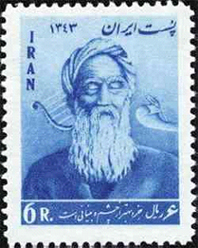
Rudaki depicted as a blind poet, Iranian stamp
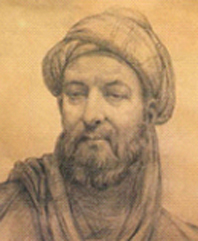
Ibn Sina
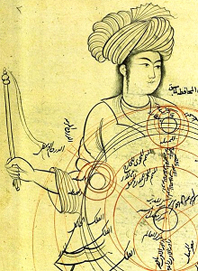
An epicyclic planetary model, from a medieval manuscript by Qotbeddin Shirazi
During the 4th century AH, Farabi (872 – 951 AD), the Persian scientist and philosopher, who also played the barbat, wrote an important book on music, kitāb al-mūsīqī al-kabīr (“The Great Book Of Music”). Although in Arabic and taken by many Arab historians to be a book about Arabic music, it is in fact about Persian music. He presents philosophical principles about music, its cosmic qualities and its influences.
Al-Farabi’s treatise on Meanings of the Intellect also dealt with music therapy, where he discusses the therapeutic effects of music. The 9th century AD saw the beginning of the breakup of Caliphate rule in Iran. Gradually a number of semi-Persian or proto-Persian kingdoms begin to develop in the Iranian parts of the Islamic empire which start promoting Persian culture. Rudaki (858 – 941), a Persian poet at the Samanid court, called the “father of Persian poetry”, and the first important poet to return to farsi language was also a chang [harp] player. He wrote a number of treaties on Persian music which have been lost.
In his wake comes Ibn Sina (980– 1037), the great Persian Physician, expert in medicine, astronomy, mathematics, philosophy and many other subjects. He also discusses music in a number of his works.
Next is Naser Khosrow (1004 – 1088) a Persian poet, philosopher and scholar. The Safarname, an account of his travels, is one of his famous works. He was well versed in all the branches of natural science, in medicine, mathematics, astronomy and astrology, in Greek philosophy and the writings of al-Kindi, al-Farabi and Ibn Sina. He was also a musician and is said to have written extensively on the subject.
After the 11th century a number of important works on Persian musicology begin to appear. The first of these is by Safi al-Din al-Urmawi (1216 – 1294) who was a renowned musician, calligrapher and writer on the theory of music. He is perhaps best known for developing in the thirteenth century the widely used seventeen-tone scale later expanded by Arab musicians to the Arabic scale of twenty-four quarter tones.
His most important works are two books on music theory, the Kitab al-Adwār and Risālah al-Sharafiyyah fi ‘l-nisab al-taʾlifiyyah. The Kitab al-Adwār is the first extant work on scientific music theory after the writings on music of Avicenna. It contains valuable information on the practice and theory of music in the Perso-Iraqi area, such as the factual establishment of the five-stringed lute (still an exception in Avicenna’s time), the final stage in the division of the octave into 17 steps, the complete nomenclature and definition of the scales constituting the system of the twelve Maghams and the six Avāz modes. It also contains precise depictions of contemporary musical metres, and the use of letters and numbers for the notation of melodies. It is the first time that this occurs in history, making it a unique work of greatest value.
By its conciseness it became the most popular and influential book on music for centuries. No other Arabic, Persian or Ottoman Turkish music treatise was so often copied, commented upon and translated into other languages. The Kitab al-Adwār was conceived as a compendium (mukhtasar) of the standard musical knowledge of its time. Al-Urmawi was in contact with the Persian scholar Nasir al-Din Tusi (1201–1274) who also left a short treatise on the proportions of musical intervals.
The next contribution came from Qotb al-Din Shirazi (1236 – 1311), a Persian poet and a Rebab player who in addition to music has made important contribution to astronomy, mathematics and medicine. He was also a Sufi thinker and wrote an important treatise on Sohrevardi’s philosophy.
The Persian poet Amir Khosro (1253-1325) is largely known for his Persian poetry but he was probably one of the most important influences on North Indian Classical Music. His writings on the Pardah system of music are a foundation stone of classical Indian music and probably explains the similarities that exist between North Indian and Iranian music. It is said he either invented the Indian Sitar or his Pardah system led directly to its invention. Sitar can make unlimited Pardah system by placing the 12-13 plectrums in various positions, thus exposing numerous potentialities.
Then comes Abd al-Qadir al-Maraghi (middle of 14th – 1435), a Persian musician and artist. Who was according to the Encyclopedia of Islam, “the greatest of the Persian writers on music“. He is known for his four works on music theory. The three surviving works are written in Persian. His most important treatise on music is the Jame’al-Alhan (Encyclopedia of Music), first written in 1405. He compiled a second edition of this work a decade later. The second major work of Abd al-Qadir is Maqasid al-Alhan (Purports of Music). The third, the Kanz al-Tu.af (Treasury of Music) which contained the author’s notated compositions, has not survived. He has also written treaties on Chinese music. He wrote songs in Persian, Arabic, Turkish and Mongolian.
Jame’al-Alhan, without any doubt is the only extant document to contain appreciable information about the modal structure of Iranian music in the pre-dastgah system. However, the definition of musical categories, the intervals of Maqam-s and their cycles, the tunning systems, the instrumentation and organological classification, and the rhythms are included in this very valuable text. For the definition of musical terms, he respectfully refers to Farabi, Ibn Sina and Safiedin Ormavi.
Recent History
Today’s formal, classical music tradition is directly linked to the music systems developed during the Safavid period (1501 – 1722). They were modified and restructured during the Qajar period into the current classical system.
Āghā Ali-Akbar Farāhāni was a renowned musician at Nasir Al-Din Shah’s court and a virtuoso tar and setar player. He is the father of two significant Iranian musicians, Mirza Abdollah and Mirza Hossein Gholi, and the paternal grandfather of another outstanding musician, Ahmad Ebadi, Mirza Abdollah’s son.
Iranian classical music relies on improvisation. Composition is based on a series of modal scales and tunes. The repertoire consists of more than two hundred short melodic movements called gusheh, which are classified into seven dastgāh (modes). Two of these modes have secondary modes branching from them called āvāz. Each gusheh and dastgah have an individual name. This whole body is called the Radif (repertoire) of which there are several versions, each in accordance to the teachings of a particular ostad (master).
Apprentices and masters, ostad, have a traditional relationship which has declined during the 20th century as music education moved to universities and conservatories. A typical performance consists of the following elements pīshdarāmad(a rhythmic prelude which sets the mood), darāmad (rhythmic free motif), āvāz (improvised rhythmic-free singing), taṣnīf (rhythmic accompanied by singing, an ode), Chahārmeżrāb (rhythmic music but rhythmic-free or no singing), reng (closing rhythmic composition, a dance tune). A performance forms a sort of suite. Unconventionally, these parts may be varied or omitted.
Towards the end of the Safavid Empire (1502-1736), more complex movements in 10, 14, and 16 beats stopped being performed. In fact, in the early stages of the Qajar Dynasty, the uṣūl (rhythmic cycles) were replaced by a meter based on the ghazal and the maqām system of classification was reconstructed into the Radif system which is used to this day. Today, rhythmic pieces are performed in beats of 2 to 7 with some exceptions. Rengs are always in a 6/8 time frame. Many melodies and modes are related to the maqāmāt of the Turkish classical repertoire and Arabic music belonging to various Arab countries, for example Iraq. This similarity is because of the exchange of musical science that took place in the early Islamic world between Persia and her neighboring countries. During the meeting of The Inter-governmental Committee for the Safeguarding of the Intangible Heritage of the United Nations, held between 28 September – 2 October 2009 in Abu Dhabi, radifs were officially registered on the UNESCO List of the Intangible Cultural Heritage of Humanity.
The classical music is vocal based. The vocalist plays a crucial role: she or he decides what mood to express and which dastgah relates to that mood. In many cases, the vocalist is also responsible for choosing the poems to be sung. If the performance requires a singer, the singer is accompanied by at least one wind or string instrument, and at least one type of percussion. There could be an ensemble of instruments, though the primary vocalist must maintain hers or his role. In some taṣnīf songs, the musicians may accompany the singer by singing along several verses. Traditionally, music is performed while seated on finely decorated cushions and rugs. Candles are sometimes lit. The group of musicians and the vocalist decide on which dastgahs and which of their gushehs to perform, depending on the mood of a certain time or situation.
Iranian classical music continues to function as a spiritual tool as it has throughout its history, and much less of a recreational activity. Compositions can vary immensely from start to finish, usually alternating between low, contemplative pieces and athletic displays of musicianship called tahrir. The incorporation of religious texts as lyrics were replaced by lyrics largely written by medieval Sufi poets, especially ghazals of Hafez and Shamsa.
Dastgah-e Shur (considered the mother of all dastgahs)
Avaz-e Abu’ata
Avaz-e Bayat-e Tork
Avaz-e Afshari
Avaz-e Dashti
Dastgah-e Homayoun
Avaz-e Bayat-e Esfahan
Dastgah-e Segah
Dastgah-e Chahargah
Dastgah-e Rastpanjgah
Dastgah-e Mahur
Dastgah-e Nava

